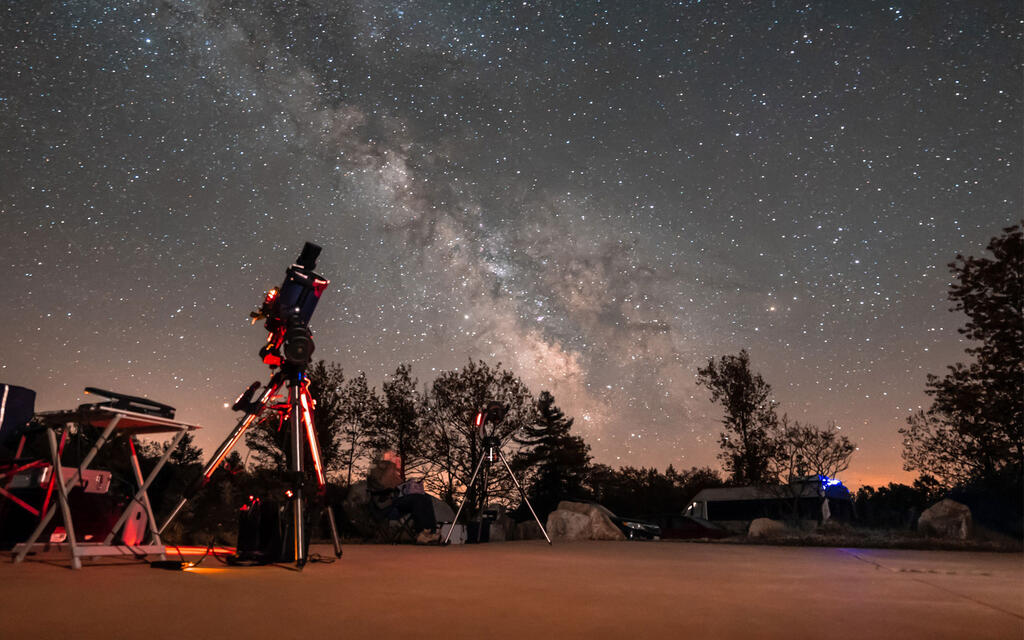Fall is the perfect time for astronomy lovers to explore the night skies no matter where you are, but especially in Ontario’s Highlands, known for some of the darkest skies in the province. In fall, the cold air holds less moisture than warm air so the night sky is amazingly clear; plus, this is the time of year when some amazing astronomical events take place each year.
This year we have some epic stargazing conditions to take in. Bundle up with a thermos and settle back to drink in the millions of stars overhead. Read on to discover when and where to stargaze in Ontario’s Highlands this October.
Where to Stargaze
The best part about stargazing (besides that it's completely FREE!) is that it can be done almost anywhere, in a farmer's field, at your local park or even in your own backyard. That said, there are some locations that are obviously better than others, and usually the more remote the better, as there will be less light pollution obscuring the night sky.
In Ontario's Highlands, our night skies are clear and bright! In fact, our region is home to two spots with some of the darkest skies in Ontario, North Frontenac and Lennox & Addington. Here, you can observe the night skies at the North Frontenac Astronomy Park or the Lennox & Addington Dark Sky Viewing Area.
Other parts of Ontario's Highlands are also dedicated to preserving the night sky, and many have by-laws in place to keep light pollution to a minimum. The point is, you can go almost anywhere in our region and be assured of a phenomenally starry night (weather permitting).
Here's a list of celestial events taking place this fall:
Draconid Meteor Shower
When: Peaks Oct. 6 to 10
Have you ever heard of Draco the Dragon? Neither had we, but the name alone will inspire you to try and catch this meteor shower this fall. The Draconid Meteor Shower passes through the skies in Ontario each October and at its peak you will have a chance to see approximately 10 meteors per hour streaking through the night sky.
Hunter’s Moon
When: Oct. 7, 2025
The full moon in fall seems more brilliant, larger, and rounder, and closer to the earth. The Hunter's Moon takes place in October and its name comes from the Anglo Saxons, referring to the time of the year when hunters are out hunting or preserving game.
Orionids Meteor Shower
When: Peaks Oct. 20 to 21, 2025
Watch the night skies for up to 20 meteors that will streak across the sky every hour during this meteor shower. Fun fact: the Orionids are named after Orion because the meteors appear to originate from the same area of the sky as that constellation. This shower is active between Oct. 2 and Nov. 7 but peaks Oct. 20 to 21 where a moonless sky will also make for the best viewing conditions.
Taurid Meteor Shower
When: Peaks Nov. 8 to 9, 2025
These meteor showers are renowned for their fireballs, and are often visible even outside of the new moon calendar.
Super Full Moon
When: Oct. 7 and Nov. 5, 2025
No, a super moon does not refer to a moon with a red cape fluttering behind it, it’s a celestial phenomena that takes place when the full moon or new moon occurs during the moon’s closest approach to Earth. Because the orbit of the moon is an elliptical there are times when the moon is closer to the earth, which, when combined with the full moon or new moon gives astronomers some spectacular views of the moon surface.
Leonids Meteor Shower
When: Peaks Nov. 17 to 18, 2025
This annual meteor shower is actually active for most of November, with the peak spanning two days. This is the fastest of all known annual meteor showers, and makes for stellar stargazing opportunities. This year moonlight won't interfere with the views because the waning crescent only rises close to dawn during the peak period.




